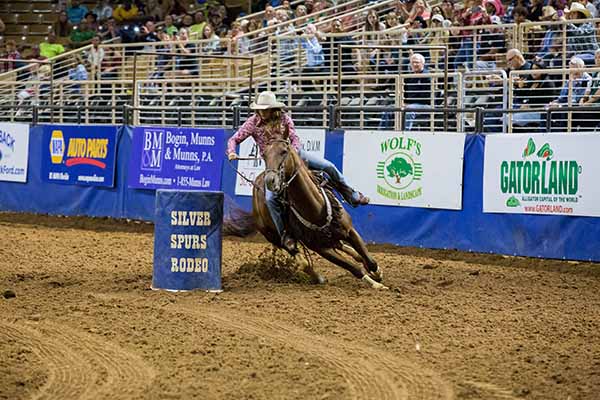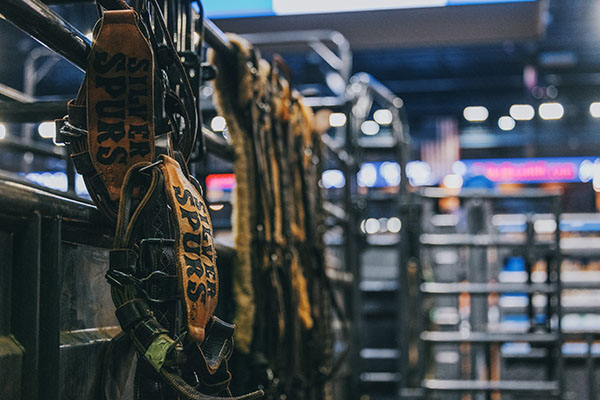

Bull Riding is the rodeo’s most thrilling and dangerous event, where cowboys must ride a bucking bull for eight intense seconds using only a bull rope for a handhold.
The contestant mounts a 2,000-pound bull and grasps a flat braided rope tied around the bull’s chest. With one hand on the rope and the other in the air, touching the bull or themselves with the free hand results in no score. The rope, tightened around the bull, is the cowboy's lifeline. Unlike other roughstock events, bull riders aren’t required to spur the bull (have their spurs touching the bull), though it can boost their score.
Judges score both the rider and the bull, each out of 50 points, for a potential total of 100 points. Riders are judged on balance, reflexes, and coordination with the bull’s movements. Bulls are evaluated on their bucking style, whether they spin tightly, jump high, or buck fiercely. The combined performance determines the final score.

Barrel Racing combines horsemanship and the horse's agility in a fast-paced event. The rider maneuvers the horse in a cloverleaf pattern around three barrels set in a triangle. The goal is to complete the run as quickly as possible, with the time recorded by an electric eye or a judge with a flag.
The race starts when the horse and rider cross the start line at full speed. They can circle either the left or right barrel first, then cross to the opposite barrel, and finally, race around the third barrel. The clock stops once they cross the finish line. Riders can touch the barrels, but knocking one down adds a five-second penalty per barrel.

Ranch Bronc Riding differs from saddle bronc riding and bareback riding primarily due to the equipment and riding style. In ranch bronc riding, riders use a regular working ranch saddle and stirrups. While saddle bronc riding uses specialized saddles without horns and requires riders to use only one free hand on a single rein.


bull riding
The contestant mounts a 2,000-pound bull and grasps a flat braided rope tied around the bull’s chest. With one hand on the rope and the other in the air, touching the bull or themselves with the free hand results in no score. The rope, tightened around the bull, is the cowboy's lifeline. Unlike other roughstock events, bull riders aren’t required to spur the bull (have their spurs touching the bull), though it can boost their score.
Judges score both the rider and the bull, each out of 50 points, for a potential total of 100 points. Riders are judged on balance, reflexes, and coordination with the bull’s movements. Bulls are evaluated on their bucking style, whether they spin tightly, jump high, or buck fiercely. The combined performance determines the final score.

Junior Bull Riding
quadrille

Steer wrestling
Starting in boxes on either side of a chute, the bulldogger and hazer chase the steer after it gets a head start. Breaking the barrier early adds a 10-second penalty.
The hazer guides the steer towards the bulldogger, who slides off his horse, hooks his arms around the steer's horns, and digs his feet in to wrestle the steer to the ground. The clock stops when the steer is on its side with all four feet pointing in the same direction.

team roping
After a successful catch, the header dallies the rope to his saddle and turns the steer, positioning its hind legs toward the heeler. The heeler then ropes both hind legs; catching only one leg adds a five-second penalty. The clock stops when both ropes are tight, and the horses face the steer.
Mutton Bustin'

saddle bronc riding
Riders must follow the “mark out” rule, with both spurs touching the bronc’s shoulders until its feet hit the ground. Failure to do so results in disqualification. Unlike bareback riding, the saddle bronc rider holds only a thick rein attached to the bronc’s halter. One hand holds the rein while the other stays in the air; touching the bronc or their own body with the free hand results in disqualification.
Judges score both rider and bronc out of 50 points each, for a total of 100. The rider's control, spurring action, and outward-pointed toes are evaluated. The bronc’s bucking ability and the smoothness and rhythm of the ride also factor into the final score.

tie down roping
Break Away Roping

Barrel racing
The race starts when the horse and rider cross the start line at full speed. They can circle either the left or right barrel first, then cross to the opposite barrel, and finally, race around the third barrel. The clock stops once they cross the finish line. Riders can touch the barrels, but knocking one down adds a five-second penalty per barrel.

junior Barrel racing

bareback riding
With just a riggin’ and his arm, the cowboy faces a physically demanding challenge. The riggin’ is a suitcase-style handhold attached to leather wrapped around the bronc’s girth. Before the chute opens, the cowboy ensures a tight grip and marks out by touching both spurs to the bronc’s shoulders until its feet hit the ground. Failing to mark out results in disqualification.
As the bronc bucks, the cowboy pulls his knees up and rolls his spurs up the bronc’s sides, straightening his legs to the shoulders when the bronc descends. This motion is repeated for eight seconds.
Judges score both rider and bronc out of 50 points each for a total of 100. The rider’s spurring technique and toe position are evaluated, while the bronc’s unique bucking style is also considered.

.avif)






